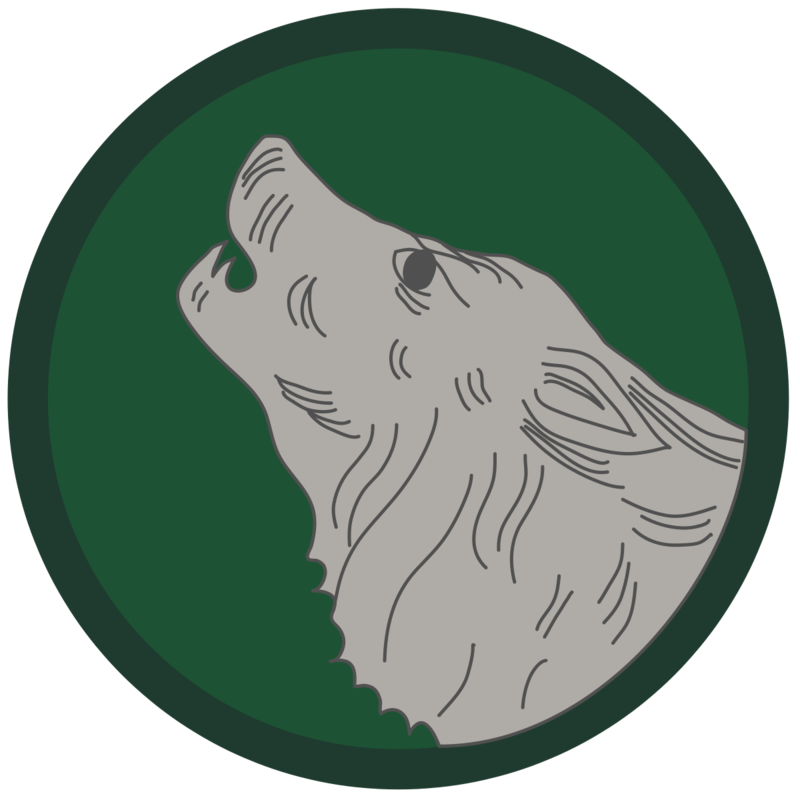Being a proud Timberwolf myself, I wanted to take a moment to share what makes my unit unique to the Army's big picture scheme. It's a bit of a read but I hope some of you find it educating.
With the outbreak of World War II, the 104th Infantry Division was activated at Camp Adair, Oregon, on 15 September 1942. Over the next two years, the unit would train throughout the Pacific Northwest to get ready for combat. Many of their training areas were inhabited by Timberwolves. The Timberwolves would frequent the division base camps in hopes of getting some food. It got to the point where whenever the division was out in the field, there was sure to be Timberwolves in the area. Before long, the division adopted the Timberwolf nickname. The Timberwolf on the coin can be seen howling up in the air, no doubt communicating with some other members of its pack that the 104th Infantry Division was in the area.
After a year of training, the 104th Infantry Division received a new commander, Maj. Gen. Terry Allen. Allen was an experienced warfighter, who had commanded the 1st Infantry Division in North Africa and Sicily during the early years of World War II. During his time with the 1st Infantry Division, Allen determined that a unit could gain an advantage over the enemy if they became skilled at fighting at night. Under the direction of their commander, the 104th Infantry Division became the first U.S. Army division to be trained to fight in nighttime conditions.
Allen stressed that night fighting required well-disciplined fit troops with map-reading proficiency, orientation to night movement and skilled in patrolling. He also stressed that the battle plans must be simple, with key terrain features as objectives. This ability would greatly benefit the division during its combat deployment to Europe as they used them to great effect with minimal casualties. This ability led to the second unit nickname, Nightfighters.
The 104th Infantry Division arrived in France on 7 September 1944. From there, they would go to the Belgian-Dutch border where they participated in an allied offensive to liberate the Netherlands from the German Army. After that offensive operation, the division reverted to defensive positions and was assigned a sector to defend against Hitler’s last major offensive on the Western Front, which came to be known as the Battle of the Bulge.
From 15 December 1944 to 22 February 1945, the Timberwolves held strong
against the German Army attack. After its unsuccessful attempt to split the Allied forces defensive line, the German Army would retreat, and the Allied forces, to include the 104th Infantry Division, would pursue.
During one night attack, the 104th Infantry Division soldiers would rely on these weapons. They were issued hand grenades and bayonets (with no ammunition for their rifles) and were told to close with and destroy the enemy. The Timberwolves were instructed that anyone firing a weapon was an enemy and should be attacked.
Using these methods honed in the Pacific Northwest during their training for war, the 104th Infantry Division successfully completed over 195 days of continuous combat without once giving up ground to the enemy. Much like their Timberwolf mascot, the 104th Infantry Division utilized their nocturnal skills and hunted their prey (The German Army) at night to conserve ammunition.
Much like our 104th Infantry Division forefathers, the current Timberwolves continue to pursue excellence as they train the next generation of leaders. From Timberwolves supporting ROTC programs, who succeed with limited resources to provide top-notch training during field training exercises and Cadet Summer Training to Timberwolves, who provide new cadets with an introduction to the Army during Cadet Basic Training, the 104th Training Division Soldiers continue a great legacy of excellence. Timberwolves, be proud of your division history and legacy that you continue to build!



 Military History
Military History



